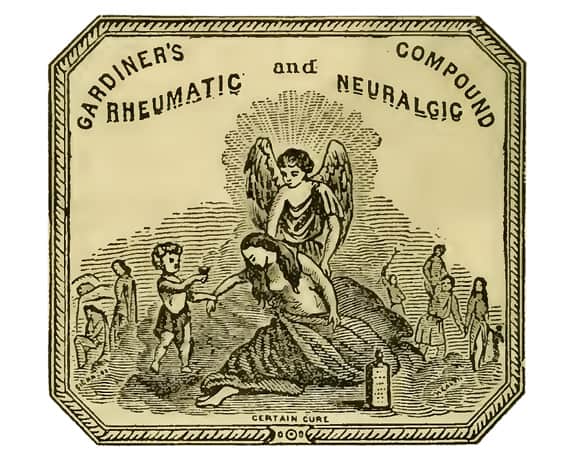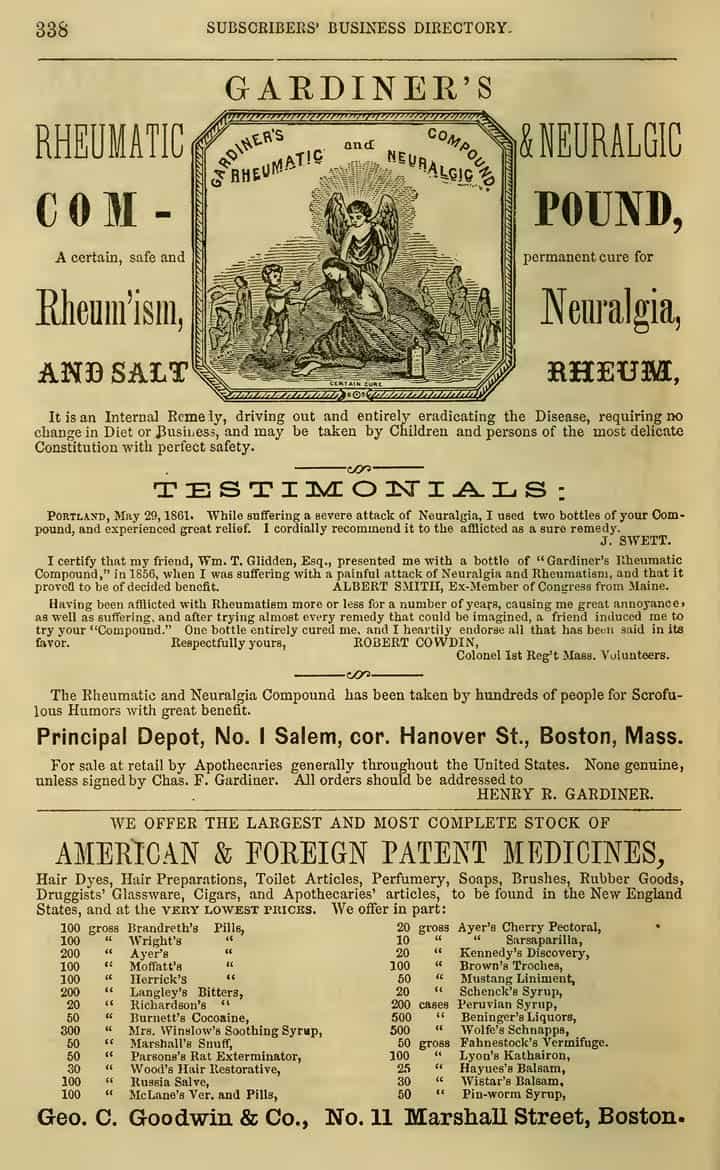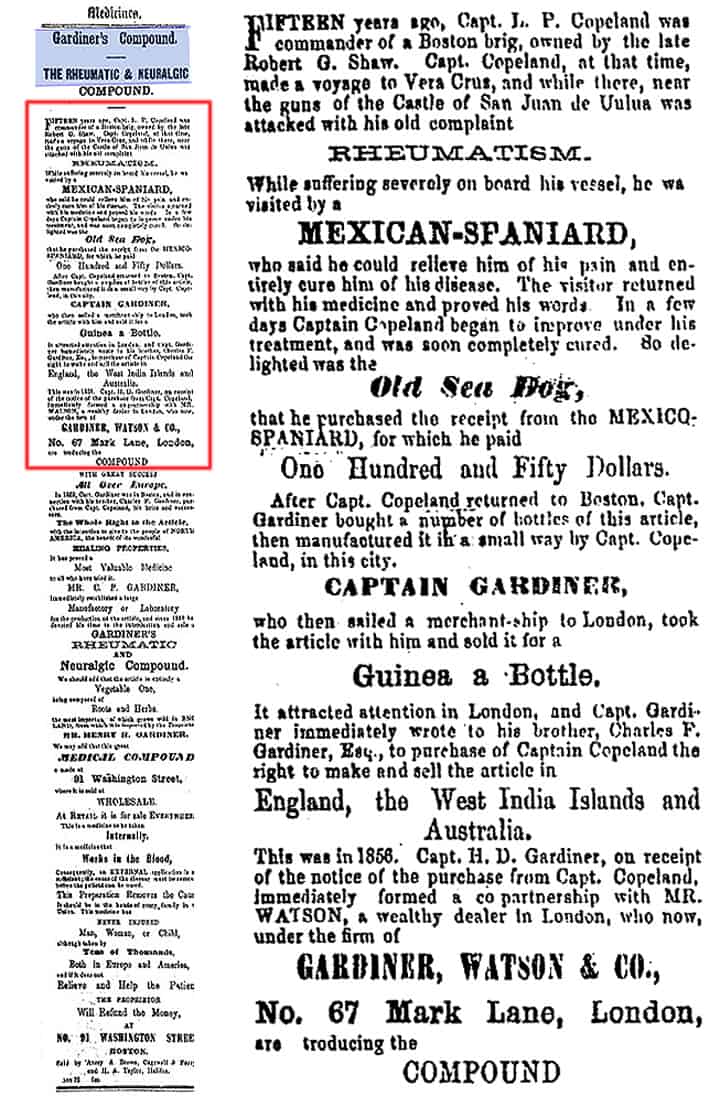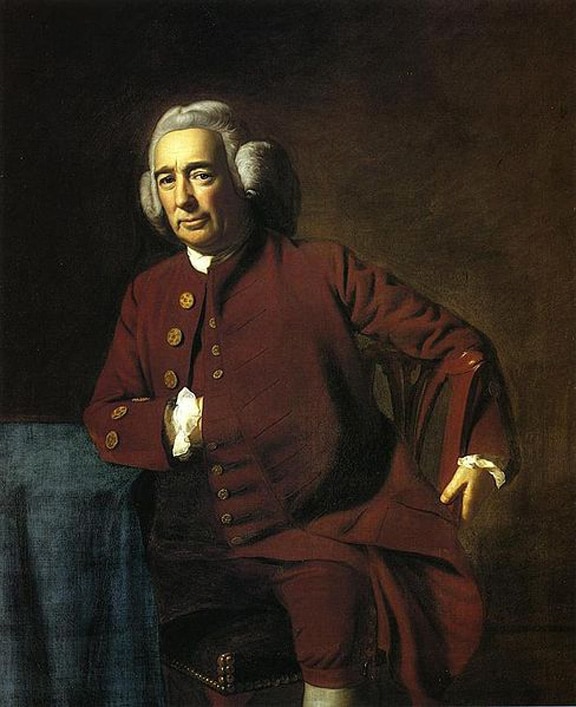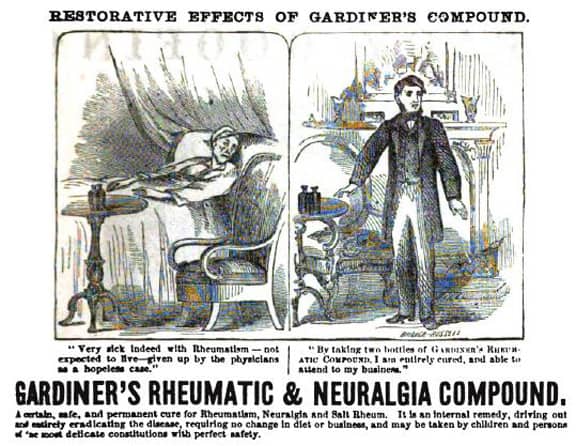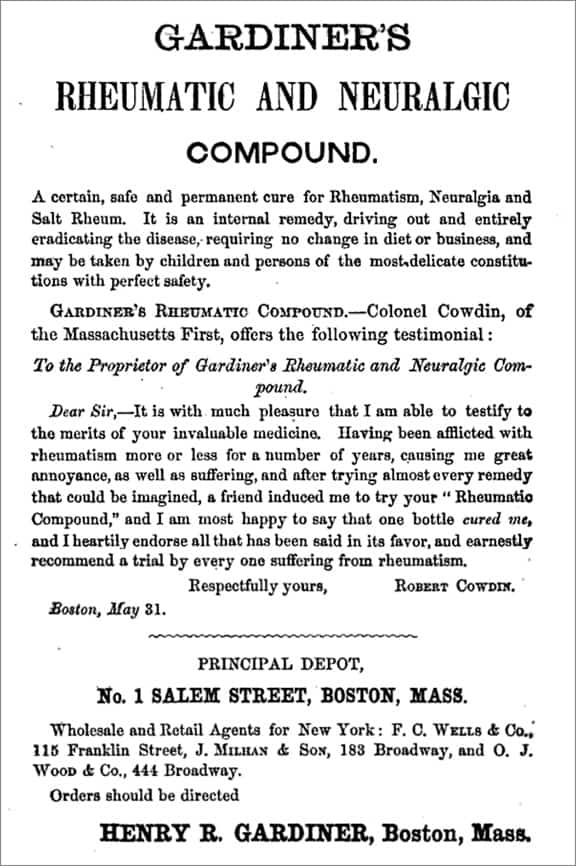Looking at Gardiner’s Rheumatic and Neuralgic Compound
14 November 2013 (R•111513)
![]() I am always on the lookout for well designed advertising promoting a product in the time period of my bottles. As a designer, I especially like the illustrations, lithography and typography. This advertisement below from an 1861 Maine directory for Gardiner’s Rheumatic and Neuralgic Compound fascinated me with the product name, testimonials and general layout. Look at that super illustration of an angel helping an ailing women with the product bottle proudly displayed. The cherub is offering the medicine in a dose glass. I suppose those are zombies in the background.
I am always on the lookout for well designed advertising promoting a product in the time period of my bottles. As a designer, I especially like the illustrations, lithography and typography. This advertisement below from an 1861 Maine directory for Gardiner’s Rheumatic and Neuralgic Compound fascinated me with the product name, testimonials and general layout. Look at that super illustration of an angel helping an ailing women with the product bottle proudly displayed. The cherub is offering the medicine in a dose glass. I suppose those are zombies in the background.
So delighted was the Old Sea Dog, that he purchased the receipt from the MEXICO-SPANIARD for which he paid One Hundred and Fifty Dollars.
A special thanks to Marianne Dow for providing valuable support information for this post.
I can not find out much about Charles F. Gardiner as he just appears from about 1859 1856 – 1862 1873 but there is quite a bit of information on a Dr. Silvester Gardiner. If I could only link the two. So far no luck. *Updated timeline*
1708 – 1786: Dr. Silvester Gardiner (June 29, 1708 – August 8, 1786) *Read below
1808: Charles Frederick Gardiner, was born Oct. 11, 1808, and married Emeline Clay. – The Gardiners of Narragansett: being a genealogy of the descendants of George Gardiner, the colonist, 1638
1833: Charles F. Gardiner, Ensign, Sept. 21, 1833; Captain, Aug. 22, 1835
1861: Gardiner C. F. proprietor rheumatic compound, 87 Kilby, house 70 Webster, E.B. – City of Boston Directory listing.
1661: Gardiner’s Rheumatic & Neuralgic Compound advertisement – “None genuine unless signed by Charles F. Gardiner“. “All orders to addressed to Henry R. Gardiner“. Principal Depot 1 Salem cor. Hanover St., Boston, Mass.
1861: Charles F. Gardiner revoked the power of attorney given to McLellan, and executed another power of attorney, authorising his brother Henry D. Gardiner to … – The Law Times Reports: Containing All the Cases Argued and Determined in the House of Lords, etc. – 1866
1867: Law reports, digests, etc. The facts were as follows: Charles Frederick Gardiner and Henry Dearborn Gardiner, were ship-builders at Boston, and were in the habit, in the course of their trade, of sending ships built by them to England and other countries for sale. – English Reports Annotated
1873: Charles Frederick Gardiner, son of John and Phebe Gardiner, removed to Cambridge, Mass., and died June 10, 1873. – The Gardiners of Narragansett: being a genealogy of the descendants of George Gardiner, the colonist, 1638
CAPTAIN GARDINER who then sailed a merchant-ship to London, took the article with him and sold it for a Guinea a Bottle.
The ‘Story’ (so they say) as it was told in this 1866 advertisement below:
FIFTEEN years ago, Capt. L. P. Copeland was commander of a Boston brig, owned by the late Robert G. Shaw. Capt. Copeland, at that time, made a voyage to Vera Cruz, and while there, near the guns of the Castle of San Juan de Ulua, was attacked with his old complaint RHEUMATISM.
While suffering severely on board his vessel, he was visited by a MEXICAN-SPANIARD who said he could relieve him of his disease. The visitor returned with his medicine and proved his words. In a few days Captain Copeland began to improve under his treatment, and was soon completely cured. So delighted was the Old Sea Dog, that he purchased the receipt from the MEXICO-SPANIARD for which he paid One Hundred and Fifty Dollars.
After Capt. Copeland returned to Boston, Capt. Gardiner bought a number of bottles of this article then manufactured it in a small way by Capt. Copeland, in this city. CAPTAIN GARDINER who then sailed a merchant-ship to London, took the article with him and sold it for a Guinea a Bottle.
It attracted attention in London, and Capt. Gardiner immediately wrote to his brother, Charles F. Gardiner, Esq., to purchase of Captain Copeland the right to make and sell the article in England, the West India Islands and Australia.
That was in 1856. Capt. H. D. Gardiner, on receipt of the notice of the purchase from Capt. Copeland, immediately formed a co-partnership with Mr. WATSON, a wealthy dealer in London, who now under the firm of GARDINER, WATSON & CO., No. 67 Mark Lane, London, are introducing the COMPOUND.
Dr. Silvester Gardiner
Dr. Silvester Gardiner (June 29, 1708 – August 8, 1786) was a physician, pharmaceutical merchant and visionary land developer of Maine.
He was born in South Kingstown, Rhode Island, the son of William Gardiner and Abigail Remington. After studying medicine in New York, London and Paris, Dr. Gardiner opened a practice in Boston, where he became a lecturer on anatomy. He actively promoted inoculation for small pox, for which he proposed and established a hospital in 1761. But he made his fortune importing drugs for distribution and sale. He contributed generously to the construction of Boston’s King’s Chapel, where he was a warden, and also to the compilation and publication of a prayer book. But he is most remembered for his purchase and development of over 100,000 acres of wilderness on the Kennebec River in Maine, where he founded what is today the city of Gardiner.
A proprietor of the old Plymouth Patent, his efforts to settle the territory were unceasing between 1753 and the American Revolution. He selected the location of Gardinerstown Plantation, established in 1754 at the head of navigation on the Kennebec River, at its confluence with the Cobbosseecontee Stream, which had falls to provide water power for industry. A millwright, carpenter and other workmen were induced to settle and build his town. He promoted immigration and land cultivation. He contributed a valuable library, and built the first Episcopal church in Pittston, from which Gardinerstown would be set off in 1760.
But in 1774, Dr. Gardiner added his name to a letter addressed to Massachusetts Royal Governor Thomas Hutchinson, affirming his allegiance to the Loyalist cause. When the British army evacuated Boston in 1776, Dr. Gardiner fled to Halifax, Nova Scotia. With few of his possessions, he then lived in Peel, England throughout the Revolutionary War.
In 1778, his name appeared on the proscription and banishment act, and his vast landholdings were confiscated. Even his personal collection of rare books were sold at auction. Because of an error in the confiscation of the Maine property, however, his heirs would be able to secure its return.
In 1783, Dr. Gardiner spent time in St. John’s, Newfoundland, and in 1784 wrote a report enumerating its resources, advocating 11 reasons for settlement. In 1785, he returned to Newport, Rhode Island, where he died the following year and was interred under Trinity Church. The Christ Episcopal Church, built in 1820 beside the Gardiner common, bears his cenotaph. [Wikipedia]

